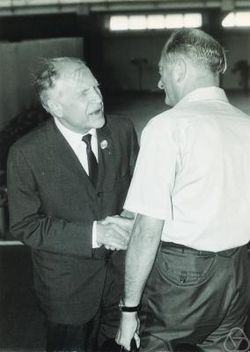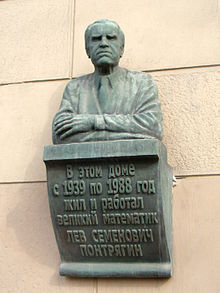Lev Pontryagin
Lev Pontryagin | |
|---|---|
 Lev Semyonovich Pontryagin (left) | |
| Born | 3 September 1908 |
| Died | 3 May 1988(aged 79) Moscow,Soviet Union |
| Nationality | Soviet Union |
| Known for | Pontryagin duality Pontryagin class Pontryagin cohomology operation Pontryagin's maximum principle Andronov–Pontryagin criterion |
| Scientific career | |
| Fields | Mathematics |
| Doctoral advisor | Pavel Alexandrov |
| Doctoral students | Dmitri Anosov Vladimir Boltyansky Revaz Gamkrelidze Mikhail Postnikov Mikhail Zelikin |
Lev Semyonovich Pontryagin(Russian:Лев Семёнович Понтрягин,also writtenPontriaginorPontrjagin,first name sometimes anglicized asLeon) (3 September 1908 – 3 May 1988) was aSovietmathematician.Completely blind from the age of 14, he made major discoveries in a number of fields of mathematics, includingalgebraic topology,differential topologyandoptimal control.
Early life and career[edit]
He was born inMoscowand lost his eyesight completely due to an unsuccessfuleye surgeryafter aprimus stoveexplosion when he was 14. His mother Tatyana Andreyevna, who did not know mathematical symbols, read mathematical books and papers (notably those ofHeinz Hopf,J. H. C. Whitehead,andHassler Whitney) to him, and later worked as his secretary. His mother used alternative names for math symbols, such as "tails up" for the set-union symbol.[1]
In 1925 he enteredMoscow State University,where he was strongly influenced by the lectures ofPavel Alexandrovwho would become his doctoral thesis advisor. After graduating in 1929, he obtained a position atMoscow State University.In 1934 he joined theSteklov Institutein Moscow. In 1970 he became vice president of theInternational Mathematical Union.
Work[edit]
Pontryagin worked ondualitytheory forhomologywhile still a student. He went on to lay foundations for the abstract theory of theFourier transform,now calledPontryagin duality.Using these tools, he was able to solve the case ofHilbert's fifth problemfor abelian groups in 1934.
In 1935, he was able to compute the homology groups of the classical compactLie groups,which he would later call his greatest achievement.[2]
WithRené Thom,he is regarded as one of the co-founders ofcobordism theory,and co-discoverers of the central idea of this theory, that framed cobordism andstable homotopyare equivalent.[3]This led to the introduction around 1940 of a theory of certaincharacteristic classes,now calledPontryagin classes,designed to vanish on amanifoldthat is aboundary.
In 1942 he introduced the cohomology operations now calledPontryagin squares.Moreover, inoperator theorythere are specific instances ofKrein spacescalledPontryagin spaces.
Starting in 1952, he worked inoptimal controltheory. Hismaximum principleis fundamental to the modern theory of optimization. He also introduced the idea of abang–bang principle,to describe situations where the applied control at each moment is either the maximum positive 'steer', or the maximum negative 'steer'.[citation needed]
Pontryagin authored several influential monographs as well as popular textbooks in mathematics.

Pontryagin's students includeDmitri Anosov,Vladimir Boltyansky,Revaz Gamkrelidze,Yevgeny Mishchenko,Mikhail Postnikov,Vladimir Rokhlin,andMikhail Zelikin.
Controversy and antisemitism allegations[edit]
Pontryagin participated in a few notorious political campaigns in the Soviet Union. In 1930, he and several other young members of theMoscow Mathematical Societypublicly denounced as counter-revolutionary the Society's headDmitri Egorov,who openly supported the Russian Orthodox Church and had recently been arrested. They then proceeded to follow their plan of reorganizing the Society.[2]
Pontryagin was accused of anti-Semitism on several occasions.[2]For example, he attackedNathan Jacobsonfor being a "mediocre scientist" representing the "Zionism movement",while both men were vice-presidents of theInternational Mathematical Union.[4][5]When a prominent Soviet Jewish mathematician,Grigory Margulis,was selected by theIMUto receive theFields Medalat the upcoming 1978ICM,Pontryagin, who was a member of the executive committee of the IMU at the time, vigorously objected.[6]Although the IMU stood by its decision to award Margulis the Fields Medal, Margulis was denied a Soviet exit visa by the Soviet authorities and was unable to attend the 1978 ICM in person.[6]
Pontryagin rejected charges of antisemitism in an article published inSciencein 1979.[7]In his memoirs Pontryagin claims that he struggled withZionism,which he considered a form ofracism.[5]
Publications[edit]
- Pontrjagin, L. (1939),Topological Groups,Princeton Mathematical Series, vol. 2, Princeton: Princeton University Press,MR0000265(translated byEmma Lehmer)[8]
- 1952 - Foundations of Combinatorial Topology (translated from 1947 original Russian edition)[9]2015 Dover reprint[10]
- 1962 - Ordinary Differential Equations (translated from Russian by Leonas Kacinskas and Walter B. Counts)[11]
- Pontryagin, L. S. (15 May 2014).Ordinary Differential Equations: Adiwes International Series in Mathematics.Elsevier.ISBN9781483156491.
- 1962 - withVladimir Boltyansky,Revaz Gamkrelidze,andEvgenii Mishchenko:The Mathematical Theory of Optimal Processes[12]
See also[edit]
- Andronov–Pontryagin criterionfor planar dynamical systems
- Kuratowski's theorem,also called the Pontryagin–Kuratowski theorem, on planar graphs
- Pontryagin class
- Pontryagin duality
- Pontryagin's maximum principle
Notes[edit]
- ^Robertson, Edmund; O'Connor, John (1999)."Lev Pontryagin - Biography".MacTutor.Retrieved2023-06-19.
- ^abcMaritz, Pieter (2003-06-01)."Around the graves of Petrovskii and Pontryagin".The Mathematical Intelligencer.25(2): 55–73.doi:10.1007/BF02984835.ISSN0343-6993.S2CID122503334.
- ^Mackenzie, Dana (2010),What's Happening in the Mathematical Sciences, Volume 8,American Mathematical Society, p. 126,ISBN9780821849996.
- ^O'Connor, John J; Edmund F. Robertson "Nathan Jacobson".MacTutor History of Mathematics archive.
- ^abMemoirs,by Lev Pontryagin, Narod Publications, Moscow, 1998 (inRussian).
- ^abOlli Lehto.Mathematics without borders: a history of the International Mathematical Union.Springer-Verlag,1998.ISBN0-387-98358-9;pp. 205-206
- ^Pontryagin, LS (September 14, 1979). "Soviet Anti-Semitism: Reply by Pontryagin".Science.205(4411): 1083–1084.Bibcode:1979Sci...205.1083P.doi:10.1126/science.205.4411.1083.PMID17735029.
- ^Puckett Jr, W. T. (1940)."Book Review:Topological Groups".Bulletin of the American Mathematical Society.46(5): 382–385.doi:10.1090/S0002-9904-1940-07199-X.
- ^Massey, W. S.(1953)."Book Review:Foundations of combinatorial topology".Bulletin of the American Mathematical Society.59(2): 188–190.doi:10.1090/S0002-9904-1953-09702-6.
- ^Satzer, William J. (October 21, 2015)."Review ofFoundations of combinatorial topology".MAA Reviews, Mathematical Association of America.
- ^Brauer, Fred (June 1964)."Review ofOrdinary Differential Equationsby L. S. Pontryagin ".Canadian Mathematical Bulletin.7(2): 315–316.doi:10.1017/S0008439500027119.page 316
- ^Blum, Edward Kenneth (December 1963). "Reviewed Work:The Mathematical Theory of Optimal Processesby Pontryagin, Boltyanskii, Gamkrelidze, Mishchenko ".The American Mathematical Monthly.70(10): 1114–1116.doi:10.2307/2312867.JSTOR2312867.
External links[edit]
- 1908 births
- 1988 deaths
- 20th-century Russian mathematicians
- Mathematicians from Moscow
- Academic staff of Moscow State University
- Full Members of the USSR Academy of Sciences
- Heroes of Socialist Labour
- Recipients of the Lenin Prize
- Recipients of the Order of the Badge of Honour
- Recipients of the Order of Lenin
- Recipients of the Order of the October Revolution
- Recipients of the Order of the Red Banner of Labour
- Recipients of the Stalin Prize
- Recipients of the USSR State Prize
- Blind scholars and academics
- Control theorists
- Scientists with disabilities
- Topologists
- Russian blind people
- Soviet blind people
- Soviet mathematicians
- Burials at Novodevichy Cemetery

